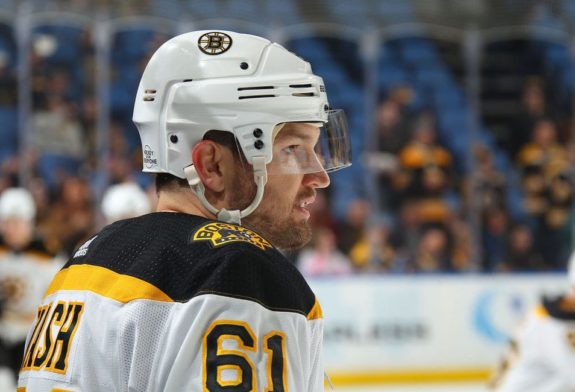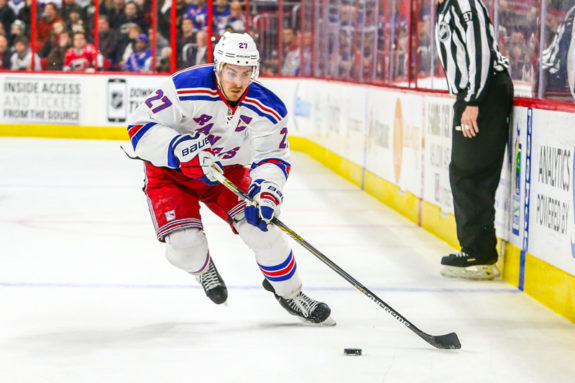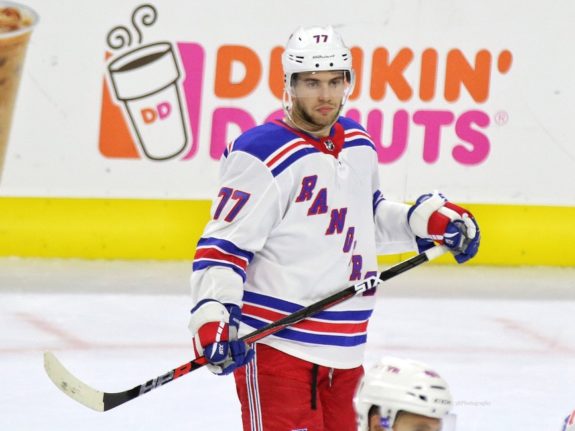Playing out the season without striving for a spot in the playoffs presents a quandary for NHL general managers.
Larry Brooks, in his latest column, is right that the NHL draft lottery “does not eliminate the paradox of winning by losing and losing by winning that organizations like the Rangers are confronting, and that is wrong. No team should benefit by losing and no team should be penalized for winning down the stretch.”
But he’s off in thinking that the Rangers are putting the wrong lineup on the ice. Long term, the Rangers are smarter to play their top youngsters now, rather than worry about moderate draft position improvements.
Is the Rangers’ Freefall Aggressive Enough?
Of late, the Rangers have seen decent results, especially for a rudderless team. They’ve won five of their last 10 and earned 11 points in their last eight contests. Brooks notes, “The post-deadline problem is that the Rangers haven’t been terrible lately. Well, not at all. Their three-goal third-period outburst…extended the Rangers’ record to 5-2-1 since Gorton emptied the cupboard.”

In calling the recent record a “problem,” Brooks is constructing an argument that the current roster is too good and success is an unwanted byproduct. But this is misguided, and fails to paint the complete picture of the Rangers’ season. New York has lost 10 of its last 15 and the seeds for the current draft-position posturing were planted months ago.
Rangers Tanking Didn’t Start at the Trade Deadline
The sample of games that Brooks references is flawed — New York gave up on aspirations as a playoff team long before the trade deadline. As such, eight games is not a fair representation of when the Rangers started their quest towards the top draft positions.
Instead, for the “formal” start to the tank, we should go back to February 8, when Glen Sather and Jeff Gorton penned a letter to the Blueshirts faithful that moves would be made in favor of the future. That date also coincides with Ryan McDonagh’s last game as a Blueshirt, as the former captain played 21:32 in a dreary 6-1 loss to Boston on the day before the letter was published. He hasn’t donned a Rangers’ sweater since.
The loss to Boston was the Rangers’ fourth consecutive and seventh loss in eight games. While the rest of the Metro division, including Pittsburgh, failed to make much progress, the Rangers failed to make any headway. A better run of games with the playoffs in reach might have changed the narrative of the season but, instead, it served as the catalyst to a meaningless February and March and a trade deadline sale that New York hasn’t embraced in over a decade.

In short, the trade deadline wasn’t the start of the tank, the letter was. Since then, captain-less, the Rangers have been, in a word, abysmal.
The Rangers Haven’t Been Good, Despite Record
The eight-game run of decent results doesn’t do justice to the Rangers’ overall poor play. In the 17 games since February 8th, the Rangers own a 7-8-2 record and are tied for 22nd in the league with 16 total points. That’s not quite top-five pick bad for a rebuilding group, but that number is grossly inflated by excellent goaltending, particularly from Henrik Lundqvist. The underlying numbers, however, present a much clearer image of the team’s performance.
Since February 8th, the Rangers’ shot attempt percentage (SAT%) of 46.20 ranks 28th in the league and only Buffalo, the Islanders, and Colorado have been worse. The Rangers also rank dead last in total shots against with 663 while Edmonton and Vancouver, who rank 30th and 29th, have surrendered just 628 SA and 613 SA, respectively, in one more game. Bottom-feeder numbers such as these are typical of tanking rosters, and these, not a handful of wins, are far more telling of how New York is currently playing.
Team charts are all set for this morning.https://t.co/tkbmcBkD0z
Chi and Cgy generate the most.
Bos allows the least.
Buf at the crossroads of dull and bad.
Nyr at the crossroads of bad and a rebuild. pic.twitter.com/APtbyJ78l3— Sean Tierney (@ChartingHockey) March 12, 2018
On top of that, the Blueshirts have benefited from playing a soft schedule. During this stretch, they have just two wins against playoff teams — Winnipeg the day after the letter, and Pittsburgh on Wednesday night. Even the worst teams in the league will win a few playing against their peers at the bottom of the standings.
How Far Could the Rangers Really Fall?
Was there any real expectation that, even with all of the moves at the deadline, the Rangers were going to end up one of the three-worst teams in the league? Had they just swapped the AHL and NHL rosters altogether, it’s still hard to imagine that the Rangers would have lost enough games to “surpass” any cellar-dwellers like Arizona, Buffalo, Vancouver and Ottawa, let alone two of them, in addition to Montreal, Detroit, Edmonton, and Chicago. Finishing fifth-worst in the league was probably the best position that the Rangers could realistically imagine.
Using Tankathon’s estimates, the 10th place finisher in the league has a 14.4% chance of getting a top-three pick in the draft, while 5th owns a 25.9% chance. The Rangers currently sit in 9th with a 5.4% chance. If we consider 5th the high-water mark, then the Rangers could, theoretically, improve their odds by 8.8%. In a vacuum, that’s a good thing. But, considering the fact that you’d still be far more likely to pick outside of the top-three picks than in it, is pushing for that 5th spot worth missing the opportunity to give rookies valuable NHL experience?
Can the Rangers Roster Get Worse?
“The Rangers are playing this straight. But given how much is at stake in claiming a top pick as opposed to a middling first-rounder, maybe they should have made a mockery of the final month by sending down their best kids at the deadline while elevating the least NHL-worthy players in their system,” Brooks said. But this, essentially, means forfeiting nearly 30 NHL contests for Rangers rookies Neal Pionk and John Gilmour and fellow blueliner Tony DeAngelo.
There’s value in getting a long look at prospects, and missing out on the extra games would shorthand the Rangers heading into an offseason in which there figures to be several moving pieces in the lineup. With their playing time, we’ve seen Gilmour’s strengths as a skater, DeAngelo’s progress with consistent minutes, and Pionk, who has five points and a plus-5 rating while averaging 24:12 per game over the last four contests, cement a spot on the blue line moving forward. Isn’t it worth knowing all of this before heading into the offseason, rather than finding out next November?

More directly, is it worth missing out on all of that experience for a 10% improved chance of getting a 26% chance at a top-three draft pick? According to Brooks, it is. But his solution to keep the three youngsters in Hartford is built around improving your odds of getting quite lucky. That’s a hard position to justify, especially since the current roster is playing poorly and sliding into a few wins by happenstance. How much worse could the Rangers actually get?
Would Ryan Sproul and Brendan Smith make the Rangers surrender more shots against? Cody McLeod, Paul Carey, and David Desharnais are all roster regulars with a combined seven points and 38.28 SAT% while Vinni Lettieri, Lias Andersson and Filip Chytil play in the AHL. Rob O’Gara has a Corsi-for percentage of just 37.1 while getting a generous 53.8% offensive-zone start rate. Short of fabricating injuries to every quality player, Gorton has to ice an actual roster, and this one has a number of black holes.
Perhaps the disappointment in the Rangers winning a few lately (that hurts to write) stems from ill-tempered expectations. The idea that New York could lose enough to have a shot at Rasmus Dahlin without a blockbuster trade was wishful thinking, and it’s long odds just to get into the top-three picks. Given that, the Rangers are right to choose an extended look at Pionk, Gilmour, and DeAngelo and the fear that they’re winning too often is based on an incomplete picture. But the volume of games the youngsters play this year will give the organization a head start on constructing next year’s roster and is a safer play than going all in on a long shot.